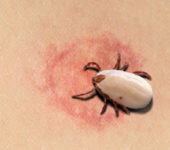
Posted On:
Category: Category:
Lyme Disease and Other Tick Borne Diseases- Their Definition and Their History !
Lyme Disease and Other Tick Borne Diseases- Their Definition and Their History !!!
Long Island N.Y. February 2, 2020
Despite its many delights, summer also brings its fair share of pestilence. One, called babesiosis, has only recently been widely recognized as a potentially serious outdoor hazard. According to a very detailed study conducted on Block Island, R.I., it could eventually rival Lyme disease as the most common tick-borne ailment in the United States.
But with reasonable precautions, neither babesiosis nor Lyme should keep you from enjoying a romp in the grass or hike in the woods.
Babesiosis is caused by protozoans that invade red blood cells and can cause a malarialike illness.
Babesiosis (pronounced buh-BEEZ-e-OH-sis) is named for Dr. Victor Babes, a Romanian pathologist who in 1888 identified the disease in cattle that had fever and blood-tainted urine. Until the mid-20th century, the disease was known only in wild and domestic animals, which can be infected by more than 100 different Babesia species.
The first human case was not recognized until 1957. A Croatian herdsman who had no spleen, an important immunological organ, died quickly of the infection, which he most likely acquired from the animals he tended. Twelve years later, the first case in an immunologically normal person was identified on Nantucket Island, and for years the disease was called Nantucket fever.
Unlike Lyme disease, which quickly leapfrogged across the country, babesiosis is spreading slowly through the Northeast and Upper Midwest, where it is increasingly recognized as the cause of a flulike summer ailment. It has been said that Lyme disease moves on the wings of birds, which some experts believe carry the bacteria causing the condition. Babesiosis, however, moves on the backs of mice and deer. Birds do not spread it.
But like the bacteria that cause Lyme disease, Babesia protozoans are transmitted to humans by ticks, which acquire the infection from the white-footed mouse and white-tailed deer. And, yes, the same tick — Ixodes scapularis, popularly called a deer tick — transmits both Lyme disease and babesiosis in this country.
The deer tick, which starts out the size of a poppy seed, requires a blood meal at every one of its developmental stages. With its hind legs clutching grass or a leaf, the tick sits patiently, holding its pincerlike front legs extended, ready to latch onto an unsuspecting mammal that happens by.
In spring or summer, that mammal could be you. In the fall, the adult tick feeds on white-tailed deer, which don’t get sick. This feeding allows female ticks to produce a profusion of eggs for the next generation.

Prevention and Treatment
As with Lyme disease, precautions to prevent the bite of a Babesia-bearing tick include staying on cleared trails to minimize contact with leaf litter, brush and tall grass; wearing socks with long pants tucked into them and long-sleeved shirts (not the most pleasant approach on a steamy summer day); and applying repellent to exposed skin and clothing. Products containing DEET can be applied directly to the skin and sprayed on clothing; those containing pyrethrins should be used only on clothing and shoes.
Daily tick checks should be as routine as brushing teeth for people in environments that could harbor ticks. Check everywhere, using mirrors if necessary, including underarms, groin, navel, back of the neck, behind knees, between toes, behind and in ears, and on the scalp.
If a tick is found, without delay use fine-pointed tweezers to grasp it close to the skin and pull upward with steady, even pressure. Do not twist or yank it. Then clean the area and your hands with rubbing alcohol or soap and water.
People who are infected can become ill one to four weeks after a tick bite. Common symptoms include fever, malaise, fatigue, chills and sweats, headache, muscle and joint pain, loss of appetite, cough and nausea. A blood test may reveal anemia.
Certain diagnosis comes from detecting the protozoan in a blood smear. Dr. Krause suggested that labs examine 300 microscopic fields before ruling out the disease.
While the infection clears in some people without treatment, most require a combination of antibiotics, usually atovaquone (Mepron) and azithromycin (Zithromax), for 7 to 10 days. Dr. Krause said even patients with mild symptoms should be treated because they may become severely ill at a later time or spread the infection to others through donated blood.
Also available are treatments on the outside of the property such as tick sprays, tick tubes, and a new product known as the tick box.
Tick sprays are generally sprayed on the lawn and throughout the yard as well. These sprays are effective at slowing down the spread of ticks to both our children as well as our animals.
Generally these sprays are done every 3 to 4 weeks around the property.
Then there is tick tubes. These are tubes that are generally known as “paper towl rolls” that are stuffed with cotton balls that are pre-treated with permethrin. These rolls are then placed amongs wood piles and various area around the yard where mice and other small animals congregate. The animals then take the cotton balls as nesting back to the wooded area and make nests. This is how we get permethrin out into the wooded areas and this onto deer and other larger animals that carry these ticks. Attacking the pre-mature ticks on the wooded environment is a largely used way to control the tick, by attacking it in its infant stage.
A new process is the use of the “tick-box.” CDC, DVBD scientists have developed and patented a host-targeted device containing a wick system that delivers the acaricide fipronil. These boxes lure rodents inside using non-toxic bait where they are passively treated. A single visit to a bait box can protect small mammals from tick and flea infestations for > 52 days.
Here is Long Island, deer is the large proponent used in the spread of ticks. Attacking the problem surrounding them in their environment is how we can control the flow of these deadly ticks in our yards.
Here at Alternative Earthcare we are very conscious of this growing problem year after year so we constantly investigating all alternative methods to control the tick problem that exists on our properties as organically as possible.










